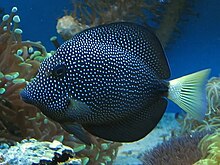| Zebrasoma gemmatum | |
|---|---|

| |
| Conservation status | |
 Data Deficient (IUCN 3.1) | |
| Scientific classification | |
| Domain: | Eukaryota |
| Kingdom: | Animalia |
| Phylum: | Chordata |
| Class: | Actinopterygii |
| Order: | Acanthuriformes |
| Family: | Acanthuridae |
| Genus: | Zebrasoma |
| Species: | Z. gemmatum |
| Binomial name | |
| Zebrasoma gemmatum (Valenciennes, 1835) | |
| Synonyms | |
| |
Zebrasoma gemmatum, the gem tang, jewelled tang, spotted tang or Mauritian tang, is a species of marine ray-finned fish belonging to the family Acanthuridae which includes the surgeonfishes, unicornfishes and tangs. This species is found in the Western Indian Ocean. The spotted tang is a highly prized specimen by marine aquarists and often commands high prices.
Taxonomy
Zebrasoma gemmatum was first formally described as Acanthurus gemmatus in 1835 by the French zoologist Achille Valenciennes with its type locality given as Mauritius. The gem tang is classified in a monospecific clade, less basal than the striped clade, Z. desjardinii and Z. velifer but moreso than the other 2 clades. The genera Zebrasoma and Paracanthurus make up the tribe Zebrasomini within the subfamily Acanthurinae in the family Acanthuridae, according to the 5th edition of Fishes of the World.
Etymology
Zebrasoma gemmatum has the specific name gemmatum, meaning "jewelled", presumed to be an allusion to the many spots on the body.
Description
Zebrasoma gemmatum has its dorsal fin supported by 4 spines and 27 or 28 soft rays while its anal fin is supported by 3 spines and 24 or 25 soft rays. The body is deep, its depth fitting into the standard length 1.6 to 1.9 times. The snout is of medium length with a concave dorsal profile. The high dorsal fin has a longest ray which would fit into the standard length between 2.6 and 3.2 times, with smaller fishes having proportionateley longer rays. The overall colour of this fish is dark brown with a large number of small white spots, these spots are typically round but some may be stretched lengthways, on the head body, anal fin and dorsal fin. The caudal fin is yellow. The maximum published total length of 22 cm (8.7 in).
Distribution and habitat
Zebrasoma gemmatum is endemic to the southwestern Indian Ocean. It has been recorded from South Africa between Kosi Bay and the Eastern Cape, although it has also been recorded from Mozambique. It is also found off Madagascar, the French Southern Territories in the Mozambique Channel, Réunion and Mauritius. This is a rare, territorial species typically found singly on coral reefs in deeper waters down to around 60 m (200 ft), typically deeper than 25 m (82 ft).
Utilisation and conservation status
Zebrasoma gemmatum is highly prized in the aquarium trade and reaches high prices in that trade. For example in 2023 prices per fish are between US$300 and US$3000. The IUCN assess the conservation status of the gem tang as Data Deficient as very little is known about its biology or how the harvest for the aquarium trade affects the population.
References
- ^ Myers, R.; Choat, J.H.; Abesamis, R.; et al. (2012). "Zebrasoma gemmatum". IUCN Red List of Threatened Species. 2012: e.T177973A1508182. doi:10.2305/IUCN.UK.2012.RLTS.T177973A1508182.en. Retrieved 18 November 2021.
- Eschmeyer, William N.; Fricke, Ron & van der Laan, Richard (eds.). "Species in the genus Zebrasoma". Catalog of Fishes. California Academy of Sciences. Retrieved 12 October 2023.
- Radu C. Guiasu and Richard Winterbottom (1993). "Osteological Evidence for the Phylogeny of Recent Genera of Surgeonfishes (Percomorpha, Acanthuridae)". Copeia. 1993 (2): 300–312. doi:10.2307/1447130. JSTOR 1447130.
- J. S. Nelson; T. C. Grande; M. V. H. Wilson (2016). Fishes of the World (5th ed.). Wiley. pp. 497–502. ISBN 978-1-118-34233-6.
- Christopher Scharpf & Kenneth J. Lazara, eds. (12 January 2021). "Order ACANTHURIFORMES (part 2): Families EPHIPPIDAE, LEIOGNATHIDAE, SCATOPHAGIDAE, ANTIGONIIDAE, SIGANIDAE, CAPROIDAE, LUVARIDAE, ZANCLIDAE and ACANTHURIDAE". The ETYFish Project Fish Name Etymology Database. Christopher Scharpf and Kenneth J. Lazara. Retrieved 12 October 2023.
- ^ Froese, Rainer; Pauly, Daniel (eds.). "Zebrasoma gemmatum". FishBase. June 2023 version.
- ^ John E. Randall (2022). "Family Acanthuridae". In Phillip C Heemstra; Elaine Heemstra; David A Ebert; Wouter Holleman; John E Randall (eds.). Coastal Fishes of the Western Indian Ocean (PDF). Vol. 5. South African Institute for Aquatic Biodiversity. pp. 219–244. ISBN 978-1-990951-32-9. Archived (PDF) from the original on 2023-06-12. Retrieved 2023-07-17.
- Miles Harrison (24 March 2023). "Gem Tang: Pricing, Care, Reef Compatibility & More". light.fish. Retrieved 12 October 2023.
External links
- Gem Tang (Zebrasoma gemmatum)
- Photos of Zebrasoma gemmatum on Sealife Collection
| Taxon identifiers | |
|---|---|
| Zebrasoma gemmatum | |
| Acanthurus gemmatus | |